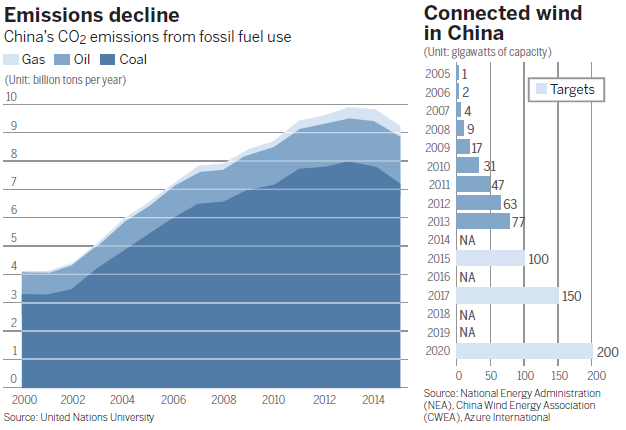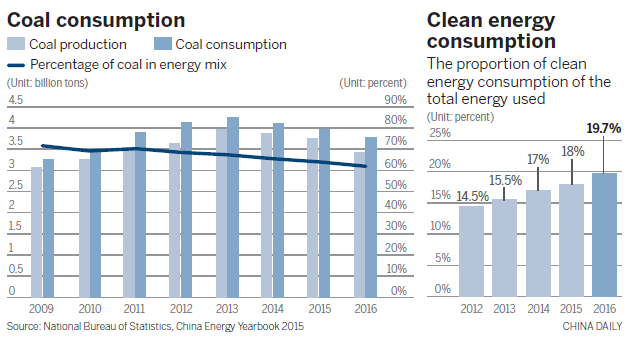Green spurt

China's coal consumption declined unexpectedly by almost 10 percent from 2014 through 2016. Since coal is the largest source of carbon emissions, this also led to a decline in greenhouse emissions long before previously projected. What made this possible?
A recent study published in Nature Geoscience by Tsinghua professor Qi Ye and coauthors concluded: "A combination of slowing GDP growth and a structural shift away from heavy industry, along with more proactive policies on air pollution and clean energy, have caused China's coal use to peak."
According to the National Bureau of Statistics, China's service sector rose to 51.6 percent of GDP in 2016, up from 46.7 percent in 2013 and 41.8 percent in 2006. The 13th Five-Year Plan (2016-20) aims for an economy in which services account for 55 to 60 percent by 2020, and the Chinese Academy of Social Sciences predicts that the service sector will contribute 72 percent of GDP by 2030.
China is in the midst of an economic transition. The earlier model, which drove growth until about 2013, was based on coal-powered heavy industry and construction. The nation's coal consumption rose almost threefold from 2000 to its peak in 2013, according to the National Bureau of Statistics.
Now, key government policies push upgrading the technology of China's industry and moving to higher value-added products, with the additional benefit of using less coal than traditional industries such as steel and cement. Large investments in green energy have made Chinese companies the world leaders in solar and wind power.
 |
|
A villager cleans solar panels on a roof in Gaomi, Henan province. Chinese companies have become the world leaders in green energy such as solar and wind power. ZHAO TAO / FOR CHINA DAILY |
Painful transition
Coal is the biggest environmental problem. According to data from BP, it causes 70 to 80 percent of China's green-house gas emissions. Tsinghua researcher Qiao Ma and colleagues found that 40 to 50 percent of PM2.5 particles come from burning coal.
Coal, the source of 69 percent of total energy consumption in 2011, went down to 66 percent in 2014 and 62 percent in 2016, according to the National Bureau of Statistics. The current five-year plan calls for coal to reach 55 percent by 2020. But coal will remain a large part of the energy mix for the foreseeable future.
The Ministry of Human Resources and Social Security predicts that 1.8 million coal workers (about one-fifth of the total) and half a million iron and steel workers are likely to lose their jobs due to capacity reduction during the Five-Year Plan period. So, the transition to a cleaner, upgraded economy will be painful.
Craig Hart, a lecturer at the Johns Hopkins University Energy Policy and Climate Change Program, put it this way: "They've sacrificed their bodies to their work and it's going to be hard to retrain them. And, the communities are almost entirely dependent on this industry and have suffered environmentally for it."
Currently, China has so many excess coalfired plants that they are, on average, running at about 48 percent of capacity, well below the optimal level. In order to control provincial and local desire to build even more coal-fired electrical power plants, China's National Energy Administration in January canceled 103 new planned and underconstruction plants. In May, the NEA prohibited 28 of China's 31 mainland prov-inces from building additional plants.
The State-Owned Assets Supervision and Administration Commission, which administers large State-owned enterprises, announced in January that at least 150 millionmetric tons of coal production facilities will be closed. In July 2016, the SASAC ordered companies under its supervision to cut coal mining capacity by 10 percent in two years and by 15 percent in five years.
However, in order to provide the power needed for continuing economic growth, the five-year plan calls for an installed capacity of 1,100 gigawatts of coal-fired electrical power plants, up from the current 920 gigawatts.
It may seem ironic that total coal-fired electrical capacity is planned to continue to expand while other coal capacity is being cut and plants are run-ning at well-below capacity. This is partly due to a reluctance, especially by local and provincial governments, to close factories and lay off workers.
It can also be partly explained by improvements in coal generation technology. The current five-year plan calls for a shift toward more efficient and less polluting new "ultra-supercritical" plants that burn at very high temperatures.
Yang Dongning, associate professor of management science at Peking University's Guanghua School of Manage-ment, says that many of the new coal plants in production are higher quality and generate less carbon emissions than the older plants that are being closed.
According to research by the Center for American Progress, a think tank in Washington, China's new, more efficient coal plants use about 280 grams per kilowatt-hour compared with roughly 370 grams per kWh in older plants, with proportional reduction in carbon emissions.
The report concludes: "We found that the nation's coal sector is under-going a massive transformation that extends from the mines to the power plants, from Ordos to Shanghai. China is indeed going green. The nation is on track to overdeliver on the emissions reduction commitments it put forward under the Paris climate agreement, and making coal cleaner is an integral part of the process."
Even though the new supercritical coal-fired electrical plants are an improvement, they still generate about twice the emissions of natural gas and far more than renewables.

Natural gas and renewables
Li Shuo, of Greenpeace's Bei-jing office, says: "In the past five years, the global emissions reduction story has been driven by two things — the surge in the use of natural gas in the US and the cut in China's coal use."
Total US greenhouse gas emissions have fallen by almost 20 percent since 2006, due almost entirely to the huge increase in the production of inexpensive shale gas made possible by the technology known as "fracking". The US has closed about half of its coal-fired power generating plants by switching to natural gas. So, why doesn't every country do the same?
Anders Hove, a consultant for the Beijing office of the Paulson Institute, explains the difficulties of fracking in China: "There are obstacles in China down the line. The shale gas is extremely deep in very high-pressure rock in mountainous regions of Sichuan and Yunnan provinces. Also, US companies with fracking experience are not able to operate freely in China. They have to have complex production sharing agree-ments and international property agreements."
Shale gas production in China did increase by 50 percent in 2016, but from a very low base. According to data from the China National Petroleum Corp, the cost of shale drilling in Sichuan has been cut by 23 percent from 2013.
China does plan to increase natural gas from 5.9 percent of its energy mix in 2016 to 10 percent by 2020 and 15 percent by 2030, according to Guo Jiaofeng, a senior researcher with the Institute for Energy and Environmental Research of the Development Research Center of the State Council, China's Cabinet, as reported by Caixin magazine.
This will be done partly by increased imports. President Xi Jinping and US President Donald Trump announced plans in May to open up and expand dramatically US liquefied natural gas exports to China as part of their 100-day action plan agreement. Total Chinese imports of LNG rose by 15.6 percent in 2016, according to the General Administra-tion of Customs. Also, a new gas pipeline from Russia will come online by the end of 2018, though a pipeline from Central Asia was canceled earlier this year.
On the other hand, China by far leads the world in building and installing solar and wind capability. According to the National Bureau of Statistics, clean energy and natural gas accounted for almost 20 percent of the energy mix. Installed solar capacity quadrupled since 2013 and China's solar panel manufacturing capacity is three times the rest of the world combined, according to research by GTM.
However, some of this solar and wind capacity ends up not being used. Much of the renewable power capability is curtailed, meaning that it is not purchased by the grid for use by customers. According to the NEA, national average wind curtailment in 2016 was 17 percent. In the western province of Gansu and the Xinjiang Uyghur autonomous region, curtailment rates of wind and solar power reached 40 and 37 percent, respectively.
Huw Slater, research director of the China Carbon Forum, explains: "The coal-powered generation plants have contracts guaranteeing a minimum level of purchases. That needs to be reformed and is currently the subject of pilot reforms."
Due to tax revenue reasons, provinces seek to buy power produced within the province and limit trade in electricity with other regions. Furthermore, the electrical grid does not choose where to source the power according to costs. That is, contracts with coal plants may shut out renewable power, even though the renewable power will certainly be cheaper at any given point that it is available and is approaching the point where it is cheaper over the lifecycle of a generating plant, according to Todd Johnson, energy specialist of the China office of the World Bank.
He argues, however, that leadership from the central government is driving toward a greener and more market-based power system.
In his speech to the World Economic Forum at Davos on Jan 17, President Xi stressed three themes - the benefits of globalization, the need to develop a dynamic innovation-driven growth model, and China's commitment to improving the environment, including the Paris agreement. He said, "It is important to protect the environment while pursuing economic and social progress - to achieve harmony between man and nature, and harmony between man and society".
And, at a news conference on March 29, Premier Li Keqiang linked improving the environ-ment to upgrading China's development model: "Efforts to cut overcapacity will be extended this year to coal-fired power generation. Together with the people who are still to be re-employed from 2016, China will need to help about 1 million workers this year.
"The key is to continue generating jobs. Thanks to the initiative of massive entrepreneurship and innovation, many jobs have been created, while traditional drivers of growth have been upgraded, which is also generating job opportunities," he said.
In the Paris climate change agreement, China committed to reaching a peak "of carbon dioxide emissions around 2030 and making best efforts to peak earlier".

















